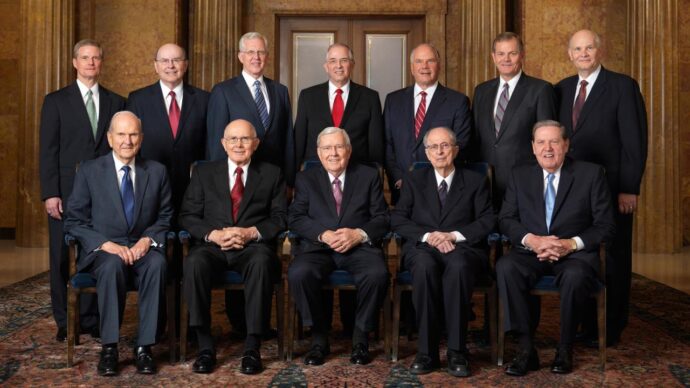I was raised in the LDS Church. In fact, I’m a sixth-generation Mormon. Or, rather, I was a Mormon until just over a decade ago when I left the church for a variety of reasons, including, but not limited to, its racism, gender inequity, and anti-LGBTQ+ policies. The last of these reasons was deeply personal since I am a transgender woman. Even before the infamous The Family: A Proclamation to the World (hereafter “the Proclamation”) was published in 1995, the church had always been anti-queer and anti-trans, although often only implicitly. I knew that I couldn’t be my authentic self in the Mormon world. They wouldn’t accept me as a girl/woman. So, I stayed in the closet until I finally left.
With the release of its new handbook for those in church leadership positions, the LDS Church is finally getting more explicit about their beliefs and practices concerning transgender folk. With respect to membership status, trans folk in the church are to be treated as second-class members, in much the same way that Black people were treated until 1978. Trans people can get baptized and confirmed, but priesthood and temple ordinations remain tied to “birth sex.”
Even attempts to socially or medically transition will now lead to other significant restrictions on membership. It’s important to note that in previous versions of the handbook such restrictions were limited to those who’ve had “elective transsexual operations”—whatever that’s supposed to mean. In other words, this policy is harsher than the previous one. Finally, note the following disturbing passage:
Some children, youth, and adults are prescribed hormone therapy by a licensed medical professional to ease gender dysphoria or reduce suicidal thoughts. Before a person begins such therapy, it is important that he or she (and the parents of a minor) understands the potential risks and benefits. If these members are not attempting to transition to the opposite gender and are worthy, they may receive Church callings, temple recommends, and temple ordinances.
Anyone who’s at all familiar with transgender care or the transgender community would know that this doesn’t make any sense. People take hormones in order to alter their bodies to be more like the gender/sex they identify with. Hormone replacement therapy is a central part of medically transitioning. And the prescribed counseling that accompanies medical transition, according to the World Professional Association for Transgender Health, is supposed to affirm trans folk’s gender identity. It’s clear that the church leaders didn’t do their homework on this one, which is not in the least bit surprising.
Theologically speaking, the new handbook has also codified Elder Dallin H. Oaks’ assertion that the term ‘gender’ means ‘biological sex a birth.’ This is significant and weird—weird because gender is also supposed to be “eternal” and a feature of our pre-mortal spirit. Presumably we don’t have spiritual chromosomes—so how can a spirit be biological? Of course, they had to make this clarification because, prior to making it, the Proclamation was clearly consistent with the common transgender narrative that there is a gender mismatch between one’s soul/spirit and one’s body. In fact, the Proclamation seems to beg for the possibility of just such a mismatch.
I myself was significantly traumatized by Mormonism, which is the case for over 70% of LGBTQ folk in the church, as a recent study by Brian Simmons out of Brigham Young University has revealed. Allowing trans folk to be open if they are willing to accept second-class “membership” is not going to be a significant change for most trans Mormons: they will continue to be traumatized by the church, even if the mode of traumatization is somewhat different. They will still be excluded, but now with a target on their backs.
The sad thing is that this is all so unnecessary. Mormon theology didn’t need to go in this direction. The church didn’t have to declare that gender is an essential and strictly binary characteristic of our pre-mortal, mortal, and post-moral existence. Prior to the Proclamation, there was nothing about Mormon theology that required such an approach. Even if the Gods and Goddesses of Mormonism can have “celestial sex” and produce sexed spiritual offspring, why assume that they wouldn’t produce sexually “ambiguous” spiritual offspring? And, as scholar Taylor Petrey and I have argued in separate papers, there are other ways to interpret Mormon theology that are more plausible than the theology in the Proclamation.
The real reason for the Proclamation, of course, was to help stop gay marriage. It was released during the fight over gay marriage in Hawaii in the 1990s. The church needed a theological document to justify its participation in the legal case. But why did they care? To understand this one must understand that the gender binary is used to impose a strict division of labor in the church between men and women that goes all the way down to the level of the family. This division gives men the bulk of the institutional power in almost every respect. If this binary complementarianism isn’t maintained then men stand to lose some of their power.
Homosexual relationships, by their very nature, problematize this patriarchal division of labor. So homosexuality is out. But when the church wrote the Proclamation they lacked the foresight to use language to exclude trans folk as well. After all, trans folk problematize the gender binary and essentialism in even more fundamental ways than gays do. Hence the recent flurry of pronouncements about trans folk and the changes in policy reflected in the new handbook insisting that ‘gender’ means ‘biological sex at birth.’ You’d think that God would possess the foresight to include this in the Proclamation in the first place.
Of course, the church has never been very clear about intersex folk and the reason is that they have never really given a good explanation of how they fit into Mormonism’s sex/gender regime. The revised handbook has more words dedicated to the topic of intersex folk, but it doesn’t really tell us anything significantly new. Essentially, it tells us that parents should counsel with medical professionals to determine the infant’s sex/gender before or soon after birth. But that was the de facto policy previously.
And what about those intersex individuals who experience gender dysphoria due to their received assignment? Don’t they have as much of a right to determine their gender as their doctors and parents? The handbook merely counsels compassion in these cases, but doesn’t explicitly say that they can’t change their gender. That remains implicit in the definition of gender as ‘biological sex at birth.’ In fact, if intersex folk who don’t identify with the gender they were assigned at birth were allowed to change their gender, then why not trans folk, whose brains might very well be intersexed? You can see how the slope gets slippery very quickly: once we grant intersex folk autonomy over their gender, then the rest of the patriarchy is revealed to be just so much straw. Once we realize that biological sex is a dynamic and multi-dimensional spectrum, as Joan Roughgarden put it, attempts to impose a gender binary will seem arbitrarily authoritarian.
The LDS Church leadership has made their rejection of trans folk more explicit than before, but what remains implicit is the fact that they’re doing this to maintain the patriarchy and that there’s an inherent lacuna in their understanding of actual biology. The fate of intersex, trans, queer, and cis women members hang together in Mormonism. It’s in all of their interests to overturn the Mormon patriarchy and initiate a reformation of the contemporary church.





